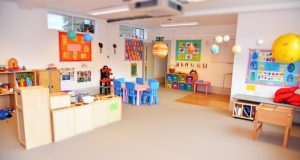Meeting the needs of children with Speech, Language and Communication difficulties is highly important, one factor to consider is how to adapt the environment to suit the children’s needs. Practitioners will need to consider what the children’s needs are and how the environment can be adapted to promote inclusion.
Many of the children with Speech, Language and Communication difficulties have good visual skills and it is good practice to promote visual support through the use of
- Visual timetables- use pictures and symbols to represent certain parts of the day/routine
- Label boxes – use pictures and symbols to show what is in the box
- Have visual displays around the room for children to look-don’t overcrowd the displays as this can be very distracting for the child.
You can also adapt the environment in other ways
- Look at the level of noise- If the noise level is very high this can be very distracting for the children and they are less likely to be able to focus on an activity.
- Keep distractions to a minimal- This will help children focus.
- Make children aware of the routine-It will help children if they are aware of the routine of the day whether this is through discussion or use of a visual timetable
- Allow children to familiarise themselves with the layout of the setting- This will help children understand where things are.

Leave a Reply